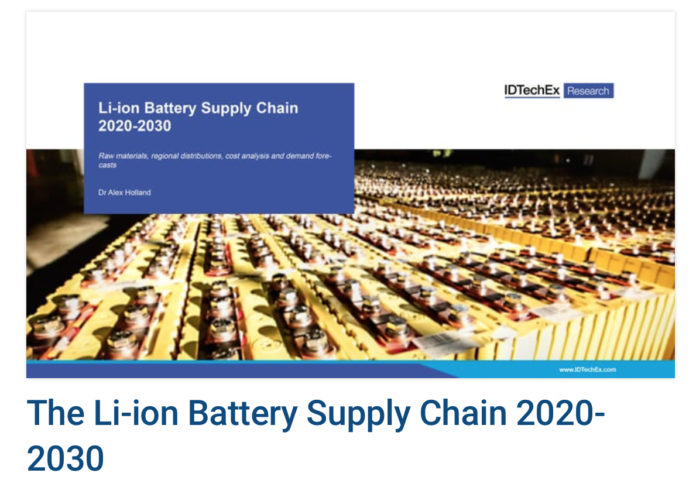Historically, growth in the li-ion battery (LIB) market has been due to consumer electronics. Moving forward, LIB demand will be driven by growth in electric vehicle (EV) adoption, which has grown steadily over the last 10 years.
The potential impact of material price volatility is discussed in IDTechEx‘s report ‘The Li-ion Battery Supply Chain 2020-2030.’ Nickel will be an important metal for LIBs, and the move by Contemporary Amperex Technology Ltd. (CATL) and GEM is one example of companies securing a long-term supply of raw materials. IDTechEx analyses and forecasts demand growth for the various materials and components that make up a LIB. Players, production capacity, production location and material trends are all discussed in the report.
Subsidies in countries such as Norway and China, especially, have encouraged EV sales. However, 2019 saw a slowdown in growth rate, primarily due to more stringent subsidy restrictions announced by China. The announcement, made in 2019, includes the removal of subsidies for pure EVs with ranges below 250 km and for battery packs with specific energies below 125 Wh/kg. Nevertheless, rapid EV growth is forecast over the coming decade.
Creating this demand are a number of underlying factors. Firstly, global emissions targets will necessitate a shift to zero-carbon transport with several countries presenting timelines for the ban of internal combustion engine (ICE) vehicles. Secondly, various auto-manufacturers have announced aggressive EV sales targets for the 2020s. Thirdly, the continuing drop in battery prices will allow EVs to reach price parity with their ICE counterparts, which will create a huge demand for EVs.
Recent investment across the LIB supply chain has been significant, and this will need to continue. The extraction and processing of raw materials is one segment that will be under increasing strain to meet demand and uncertainty over long-term supplies of raw material remain. In 2018, Chinese battery companies CATL and GEM formed part of a consortium to establish additional nickel smelting and processing facilities in Indonesia. In 2019, Indonesia brought forward restrictions on the export of nickel ore to encourage further investment from the steel and LIB industries, causing an increase in the nickel’s price.
Investment in cell and battery production has also been significant. For example, several factories have come online or are being constructed in Europe to allow EV manufacturers greater control over the LIB production process. IDTechEx’s new report discusses whether enough battery production is being brought online to meet demand. The report also presents a timeline for a number of factories that have recently been built or are under construction, providing insight into how much time is needed to increase production capacity. This increasing scale at which batteries are produced can help bring battery prices down further. IDTechEx breaks down the cost of LIBs and presents a price forecast through to 2030, accounting for historical price and volume data, increasing economies of scale, different end uses and the underlying bill of materials.
The LIB supply chain will be under increasing scrutiny as the demand for LIBs grows. IDTechEx’s report analyzes the ongoing activity in various segments of the supply chain, including technology developments, current production output and location, recent investments, timelines and players. Along with their 10-year demand forecasts and price analysis, the report provides a comprehensive overview of the LIB supply chain.
For more information on the LIB supply chain, you can read the executive summary of IDTechEx’s report here.





